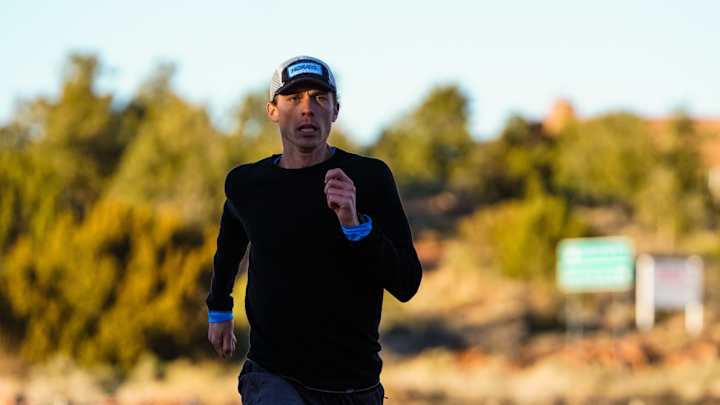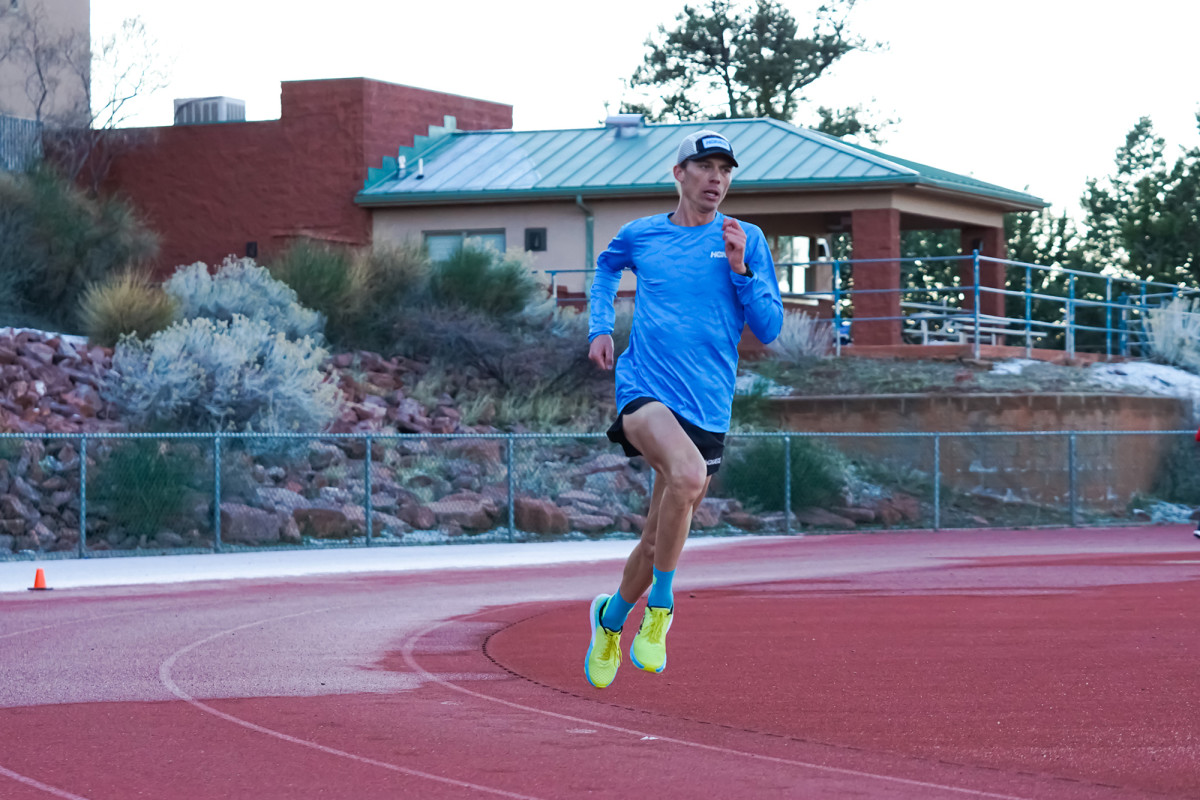Jim Walmsley’s Long, Winding and Unconventional Path to the U.S. Olympic Marathon Trials

Surrounded by Ponderosa pine forests and a backdrop of mountains, Flagstaff, Ariz., is a postcard place for professional runners. It’s an ideal running hub with open trails, few distractions and the red-blood-cell-boosting benefits of nearly 7,000 feet of altitude. It’s home to arguably the best ultramarathoner in the U.S., Jim Walmsley.
Since moving to Flagstaff in 2015, Walmsley, 30, has distinguished himself from the rest of the northern Arizona town’s runners with a string of impressive performances. His crowning moment came at the 2018 Western States Endurance Run, the world’s oldest 100-mile trail race, which goes from California’s Squaw Valley to Auburn, where he finished in a course-record 14 hours and 30 minutes. A year later, Walmsley returned and destroyed his own course record by 20 minutes. In 2019, he also set a world record for the 50-mile run in four hours, 50 minutes and eight seconds during an exhibition race put on by his sponsor, Hoka One One. Walmsley capped the year by winning the 41.5-kilometer World Mountain Running Long Distance Championships in Villa La Angostura, Argentina, in November.
Now Walmsley is preparing for a new challenge, at a shorter distance he has far less experience in: the U.S. Olympic marathon trials in Atlanta on Feb. 29.
“There’s definitely some workouts and some moments of light where I’m grinning and believing that I have a shot,” Walmsley says of his attempt at the 26.2-mile distance. “It’s a bigger process than just one day or one week. You have to go through it all and hope things align on race day.
“It’s a shot at the moon and an extremely small percent chance for me, but at the same time there are enough good days that I have a piece of me that believes.”
Building the Engine
As a runner at Horizon High School in Scottsdale, Ariz., Walmsley was already experimenting with higher mileage. He was inspired by news articles about the training and success of Kenny Cormier of Douglas, Ariz., who won the 2004 Foot Locker Cross-Country National Championships, and he set out to imitate him. It worked, as Walmsley set cross country course records during his senior year, won an individual state title in his division and then finished 23rd at the 2007 Foot Locker race. He was recruited by Arizona State, Georgetown, Iona and Washington, but chose to attend the Air Force Academy in Colorado Springs.
Under the guidance of coach Juli Benson, Walmsley was a second-team All-American in the steeplechase as a senior and he graduated in 2012 with a personal best of 13:52 for 5,000 meters. This sort of track pedigree is fairly similar to what many elite marathoners will bring to the starting line at the Olympic marathon trials. But Walmsley hasn’t attempted to improve his times at the shorter distances since 2012.
“What Jim could do on downhill runs back then was unbelievable,” Benson says. “He would bury his teammates when they would go on trail runs. It speaks to his fearlessness and athleticism.”
After graduation, Walmsley was first stationed at Vandenberg Air Force Base in California, where he trained as a missileer and served as an officer, sitting underground on alert for 24-hour shifts, supervising nuclear intercontinental ballistic missiles. In 2013, he was assigned to Malmstrom Air Force Base in Montana. The stress of the job resulted in depression.
About two months into the job, Walmsley was arrested for a DUI. After an off day of rock climbing and casually drinking with friends, Walmsley was found napping behind the wheel of his car by a Montana state trooper. He was placed on probation after the incident, and was later fired when a widespread cheating scandal on proficiency tests impacted more than 100 officers in Montana, North Dakota and Wyoming. According to an Outside Magazine profile in 2018, Walmsley said that his involvement in the cheating scandal—coupled with the DUI—led to the Air Force’s decision to give him a general discharge.
Unable to find work and unsure where to go, Walmsley moved back in with his parents in 2015 in Phoenix and sought ways to combat his deepening depression. In Montana, running was a coping mechanism for Walmsley, and he used the residual fitness from college to hop into local trail races. So he signed up for a 12K race in Helena, Montana—and won in 2013. A year later, he moved up to the 30K distance at the same event—and won again. The success led to experimentation with training for even longer distances with his new free time.
While living with his parents, Walmsley searched Craigslist for cheap Flagstaff apartments and scoured online postings for jobs from Phoenix. If an interesting opportunity presented itself, he would make the two-hour drive to Flagstaff for job interviews. In February 2015, a northern Arizona bike shop called Absolute Bikes took a chance on him as a sales associate, but even though Walmsley had some interest in cycling, he constantly felt flummoxed by customer questions about mountain bikes.
In his free time, Walmsley reconnected with Tim Freriks, a former runner at Northern Arizona University who knew Walmsley from their days as fellow high school competitors, and they started running together. Freriks recalls that period in life as transitional—
for him trying to find his postcollegiate footing and for Walmsley improving himself.
“I knew that he was fighting his own demons,” Freriks says of Walmsley. “We were both using the trails as a common pursuit and something we wanted to get good at. The trails can be a good refuge from the stressors of life.”

A Moonshot, But a Shot
On the morning of Jan. 5—just seven weeks out from his marathon debut at the Olympic trials—Walmsley wrapped up a 30-mile run on the rolling fire roads of Camp Verde, Ariz. As he does with all of his runs, he uploaded the GPS data to Strava, a fitness app and social media platform where runners and cyclists share their workouts. Shortly after, the comments and kudos (the app’s equivalent of a Facebook like) started flooding in, as Walmsley’s followers obsessed over his mile splits and elevation data.
“People see 30 miles, and they go crazy,” Walmsley says.
In Flagstaff, Walmsley usually trains with a small, local group called the Coconino Cowboys, who typically run in and out of the Grand Canyon in preparation for some of the world’s biggest ultra and trail races. But sometimes Walmsley tackles longer distances by himself. That January day, alone on the trail, Walmsley averaged about five minutes and 43 seconds per mile while climbing more than 2,000 feet over the 30-mile distance. “Sexy,” says Walmsley of the day’s work. The run garnered more than 6,400 kudos and nearly 300 comments on Strava.
“It’s difficult, and at times it sucks to be out here alone, trying to do a workout,” Walmsley says. “Sometimes I feel like you don’t get the most out of yourself when it’s just you. However, there are also special moments. You can get a lot out from really pushing yourself and keeping yourself accountable. It’s a callusing effect that can play a benefit in the marathon.”
That sounds reasonable enough, but Walmsley critics are quick to point out: How would he know if he’s never raced a marathon before?
It was not until December 2019 that Walmsley started shifting his focus to the marathon by trading in his long, slow jogs on trails for shorter, speedier daily runs. During the week, he mixes in three to four speed workouts with faster interval training. Opting to forego the guidance of a conventional coach, Walmsley has historically relied on books like The Self-Coached Runner by Al Lawrence and Mark Scheid, along with Daniels' Running Formula, by legendary coach Jack Daniels, for workout inspiration.
But for his marathon preparation, Walmsley did his own research and dug up training logs for elite Japanese marathoners from the ’80s, ’90s and early 2000s for inspiration, including two-time Olympian and four-time major marathon winner Toshihiko Seko; Japanese Olympic marathoner Takayuki Inubushi; former 100K world record holder and 2:10 personal best marathoner Takahiro Sunada; and Japanese runner Jo Fukuda, who ran 500 kilometers two weeks before a 2:10 marathon time.
Some Japanese marathoners come from a high-volume training philosophy, which aligns more with Walmsley’s background and goals. He outlined their logs on his calendar, backdating their goal race to the U.S. Olympic marathon trials. He also observed public training logs for marathoners like Jake and Zane Robertson, twin brothers from New Zealand who left their home at 17 to train among Kenyans and became world-class runners after a decade among the best.
“It’s just trying to pick up little cues that might be working outside the norm of U.S. training, especially volume-based things,” Walmsley says.
For many of the top U.S. marathoners, the trials are what fuel Olympic dreams and center four-year training cycles. The top three men and women across the finish line will go on to represent the United States at the 2020 Summer Games in Tokyo, where the marathon will be contested separately in Sapporo.
To qualify for the trials, men must run a marathon in 2:19:00 or faster or a half marathon in 64:00 or faster. Walmsley secured his spot on the starting line by the slimmest of margins and finishing the 2019 Houston Half Marathon in 64:00—the slowest time you can run to qualify using the shortest distance.
The half-marathon qualifier is arguably harder to hit, which is why Walmsley targeted it in the fall of 2018. Had he not hit it, there’s a chance he would have delayed his marathon debut. Ben Bruce, a marathoner and coach with Northern Arizona Elite (a professional training group in Flagstaff) recognizes the benefit Walmsley may have of approaching the trials with no pressure.
“One thing I think Jim has going for him is that he’s going to have a lot of fun,” Bruce says. “I think he really believes that. Some people can say the same thing but they have all these places and times in their head. Jim’s reckless attitude is to run at whatever feels right. That might be at the front early or in the middle of the pack but all of that mind-set can lead to a chance for him to finish decently well.”
There is no denying that Walmsley’s marathon debut comes with intrigue. What can the best American ultrarunner—who happens to boast a shorter-distance pedigree not too out of line with some of the U.S.’s top road runners—do when mixing it up with the country’s best marathoners and taking the most unconventional approach to training?
Walmsley’s Strava profile is certainly something to marvel at, but traditional marathoners like Galen Rupp (2016 Olympic bronze medalist), Scott Fauble (2:09:09 at the 2019 Boston Marathon) and Jared Ward (2:09:25 at the 2019 Boston Marathon) hold the advantage in experience of racing and training for the marathon for years. If the course in Atlanta is hilly and the true marathoners who prepare for the repeated elevation changes will be the ones left in contention at the end of the race.
One disadvantage Walmsley faces is his far shorter period of marathon-specific training than his competitors’. Will his abbreviated plan allow him to change gears and respond to pace surges later in the marathon?
Walmsley ran 62:13 at the Rock ’n’ Roll Arizona Half Marathon on Jan. 19, but an error on the course left half-marathon elites 286.5 meters shy of the 13.1 miles. It’s likely he still would have run a personal best around 63 minutes, but can he run that pace for twice the distance? For context, Ward hit the half-marathon mark of the New York City Marathon in 64:50 and held on to run a 2:10:45—a time that if replicated in Atlanta would likely land him on his second Olympic team.
Walmsley is not the first ultra or trail star to compete at the marathon trials—and some have fared well in the past. Just four years ago, Patrick Smyth finished eighth in 2:15:26 and has a résumé with some success at the 50K distance since 2015. The 12th place finisher was Max King, who moved to ultramarathons and the trails after disappointment at the 2008 Olympic Trials. King is a world-class mountain runner who set the 100K U.S. record and has been a contender at some of the major 100-mile races. What makes Walmsley different is that his records, dominance and victories have him coming at the marathon from a higher level than Smyth and King.
Because of the extreme distance, ultrarunners can surrender a place or two during a tough stretch of a race without losing much ground. But in a standard marathon, fading can lead to dozens of runners passing and potentially the difference between a top-10 finish and 50th. Walmsley’s signature strategy in ultras allows him to dictate the race with aggressive front-running. In the two half marathons that he’s run, he’s resorted to chasing faster people and running in a pack. There’s no telling if he will resort to his old ways for the Olympic marathon trials.
“It begs the question, Is Jim going to go out to the front of the trials and just blast it, because why not?” Bruce says. “Then everyone else has this tough decision to make: Ultimately he’ll probably get caught, but a lot of people don’t want to admit that there’s this what-if in their mind when he goes out hard and hangs on. I feel like he’ll be someone that will have an impact on the race at some point.”
Walmsley isn’t ready to reveal his race plan but acknowledges that front-running to disrupt the race would be playing with “a sharp knife” due to the talent and preparation of the competition. However, he knows it’s been done in the past with Yuki Kawauchi’s upset win at the 2018 Boston Marathon and Meb Keflezighi’s getaway at the 2014 Boston Marathon.
“The most important thing is that no matter how you choose to do it, you just need to be really passionate and put everything into it,” Walmsley says. “Being passionate about attacking something new is what’s most exciting.”
***
Just south of where Interstate 40 bisects Flagstaff, there’s a literal fork in the road, where two southbound state highways momentarily converge.
Angled slightly to the southeast is Lake Mary Road, a roughly 50-mile long, sparsely driven, two-lane expanse of asphalt with a generous shoulder. It is so frequently used as a training ground for the town’s running population that somebody spray-painted quarter-mile markers on the ground, so it’s easier to tell how far and at what pace you’ve traveled.
Adjacent to Lake Mary Road, heading generally southwest toward Sedona, Ariz., is 89A, a more heavily trafficked but rarely run-on state road. It’s narrower and has a less consistent shoulder than Lake Mary Road. Drivers are less accustomed to seeing runners, and there are no community-maintained mile markers.
Five weeks out from the trials, Walmsley set out on another lengthy run—this time, for 31 miles. As if his unconventional path to the marathon needed any more metaphor, he chose to log the majority of those 31 miles on 89A—the road less traveled, at least by his peers.
